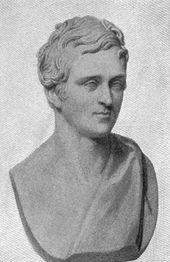Henry Hallam

Henry Hallam
Hallam was a fellow of the
Life
The only son of Rev
Hallam's earliest literary work was undertaken in connection with the Whig periodical, the Edinburgh Review, where his review of Walter Scott's Dryden attracted attention. His first major work, View of the State of Europe during the Middle Ages (two volumes),[2] was published in 1818, and was followed nine years later by The Constitutional History of England (1827, two volumes).[3] Introduction to the Literature of Europe, in the Fifteenth, Sixteenth and Seventeenth Centuries (four volumes) appeared in 1837.[4] A volume of supplemental notes to his Middle Ages was published in 1843, and in 1852 Literary Essays and Characters: Selected from "An Introduction to the Literature of Europe"[5] was published. These works represent nearly all of Hallam's career.[1]
Hallam was a fellow of the
Historical works
Hallam described his work Middle Ages as a series of historical dissertations for the period from the 5th to the 15th century. The work consists of nine long chapters: the histories of
The Constitutional History of England (1827) took up the subject at the point at which it had been dropped in Middle Ages, namely the accession of
Hallam, like
Literary history works
The 4-volume Introduction to the Literature of Europe in the Fifteenth, Sixteenth, and Seventeenth Centuries (1837–1839)
The plan excluded biographical history. It is an account of the books which would make a complete library of the period, arranged according to date of publication and subject.[9]
Death and memorials
Hallam died in London on 21 January 1859, aged 81. He has a memorial in the crypt of St Paul's Cathedral in London,[13] and there is a blue plaque at 67 Wimpole Street in London installed by the London County Council commemorating the fact that he once lived there.
Family

In 1807 Hallam married Julia Maria Elton (daughter of Sir Charles Elton). She died in 1847.[14]
Hallam lost his children, one after another. His eldest son, the poet
Notes
- ^ a b c d e Robertson 1911, p. 851.
- OCLC 863489434. 2 vols.
- OCLC 16413325. 2 vols.
- OCLC 6618679.
- OCLC 476322499.
- Lord Brougham, overlooking the constitutional chapter in the Middle Ages, censured Hallam for making an arbitrary beginning at the reign of Henry VII, and proposed to write a more complete history himself.
- ^ Robert Southey (January 1828). "Hallam's Constitutional History of England". Quarterly Review. 37: 194–260.
- ^ Robertson 1911, pp. 851–852.
- ^ a b c Robertson 1911, p. 852.
- ^ Hallam, Henry. Introduction to the literature of Europe in the fifteenth, sixteenth, and seventeenth centuries. London: J. Murray; 1839–1840.
- ^ "Review of Introduction to the Literature of Europe in the Fifteenth, Sixteenth, and Seventeenth Centuries by Henry Hallam". The Quarterly Review. 58: 29–60. February 1837.
- ^ "Review of Introduction to the Literature of Europe in the Fifteenth, Sixteenth, and Seventeenth Centuries by Henry Hallam, vols. ii, iii, iv". The Quarterly Review. 65: 340–383. March 1840.
- Sinclair, W.p. 465: London; Chapman & Hall, Ltd; 1909.
- ISBN 0-902-198-84-X. Archived from the original(PDF) on 24 January 2013. Retrieved 1 September 2016.
- OCLC 17465588.
- ^ Stephen, Leslie (1890). . In Stephen, Leslie; Lee, Sidney (eds.). Dictionary of National Biography. Vol. 24. London: Smith, Elder & Co. p. 96.
References
- This article incorporates text from a publication now in the public domain: Robertson, Edmund (1911). "Hallam, Henry". In Chisholm, Hugh (ed.). Encyclopædia Britannica (11th ed.). Cambridge University Press. pp. 851–852.
- Stephen, Leslie (1890). . In Stephen, Leslie; Lee, Sidney (eds.). Dictionary of National Biography. Vol. 24. London: Smith, Elder & Co. p. 96.
Further reading
- Landry, Peter (2011). "The Legal Philosophers, or The Jurists: Hallam, Henry (1777–1859)". Blupete. Archived from the original on 22 April 2015.
- Macaulay, Thomas Babington (September 1828). "Hallam's 'Constitutional History'". In Grieve, A. J. (ed.). Critical and Historical Essays: English History. Vol. 1. Archived from the originalon 4 December 2014.
External links


